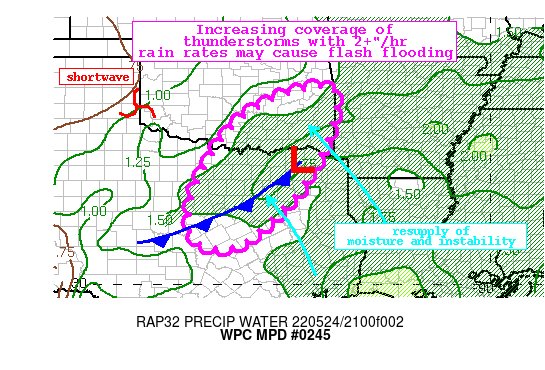
Mesoscale Precipitation Discussion 0245
NWS Weather Prediction Center College Park MD
741 PM EDT Tue May 24 2022
Areas affected...Northern Texas, Southeast Oklahoma
Concerning...Heavy rainfall...Flash flooding possible
Valid 242340Z - 250530Z
Summary...Showers and thunderstorms will expand in coverage across
parts of north Texas and spread into southeast Oklahoma this
evening. Rainfall rates of more than 2"/hr are likely, and
training of these rates could lead to flash flooding.
Discussion...An active evening of convection is ongoing across the
Southern Plains as multiple shortwaves and multiple boundaries
interact to drive widespread thunderstorm activity. A shortwave
noted on GOES-E WV imagery lifting out of the Texas Panhandle is
impinging upon a cold front draped from the Arklatex southwest
into the Edwards Plateau. Downstream of this shortwave, 850mb flow
is becoming locally backed according to the SPC RAP, and drawing
pronounced moisture and instability northward. Recent GPS
observations indicate PWs have surged above 1.5" from Dallas, TX
and points northeast, with MUCape south of the cold front
eclipsing 2000 J/kg. This locally backed flow is surging
orthogonally into the front, and then lifting isentropically into
North Texas, producing rounds of showers within this WAA regime
noted on the regional radar mosaic. West of this WAA precip, more
strongly forced thunderstorms along an outflow boundary and closer
to the shortwave are advecting eastward, with rain rates estimated
by KFWS WSR-88D of 1.5"/hr.
As the evening progresses, the cold front should gradually sag
southeastward while the LLJ increases to 20-30 kts but veers to
converge into the front rather than orthogonally lift atop it.
This will likely result in more boundary-parallel 0-6km mean
winds, while also turning Corfidi vectors to become more opposed
to this mean flow. Continued convergence along the front, combined
with modest PVA downstream of the shortwave and increasing
diffluence within the RRQ of an upper jet streak will allow
convection to expand further into southeast Oklahoma. With PWs
progged to remain at or above the 90th percentile, this expanding
convection will support rain rates which the HREF indicates could
reach 2"+/hr at times. While the mean wind will remain above 20
kts, the increasingly opposed Corfidi vectors suggest storms may
backbuild and then train along the front, prolonging the duration
of these excessive rain rates. This will likely lead to
significant rainfall accumulations, and the recent WoFS runs
continue to increase the probability for more than 3" of rainfall
in some areas.
This region has been dry noted by AHPS 7-day rainfall less than
10% of normal leading to NASA SPoRT 40cm soil moisture in the
bottom 10th percentile. However, the HREF does indicate areas with
a 10-30% chance for 1-hr and 3-hr FFG exceedance. Flash flooding
is possible, but would be most likely in any urban areas or where
any longer duration training can occur.
Weiss
ATTN...WFO...FWD...OUN...SHV...TSA...
ATTN...RFC...ABRFC...LMRFC...WGRFC...NWC...
Winter time post are almost exclusively focused on the DFW area.












